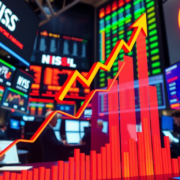China’s July Manufacturing Contraction Signals Economic Slowdown: Impact on Markets and Currency Dynamics
China’s Manufacturing Sector Contracts in July Amid Rising Tariff Pressures; Hang Seng Index and AUD/USD Experience Downward Pressure
By Bob Mason
Published: August 1, 2025, 02:27 GMT
China’s manufacturing shows a clear drop in July. Tariffs and weak demand affect production. The S&P Global China General Manufacturing PMI fell to 49.5 from 50.4 in June. The score sank below the neutral mark of 50 and missed the expected near-50 level. The drop puts extra strain on export-led companies and pushes down the Hang Seng Index and the value of the Australian dollar.
Key Highlights from July Manufacturing Data
- Manufacturing PMI fell to 49.5, marking the first drop since late 2023.
- New export orders shrank for the fourth month in a row, as US tariff risks add trade stress.
- Both manufacturing output and new orders fell, with output decreasing for only the second time since October 2023.
- Firms reduced jobs to manage costs in the face of weak demand.
- Input costs climbed for the first time in five months when raw material prices rose.
- Selling prices dropped even as input costs went up in a tough and competitive market.
- Export charges went up as shipping and logistics costs increased.
- Manufacturer mood improved a little but stayed below usual levels as they watched for better economic signs and government moves.
Expert Analysis on China’s Manufacturing Conditions
Jingyi Pan, Economics Associate Director at S&P Global Market Intelligence, said, "Production slowed because new orders grew more slowly. Local business helped keep some orders, but weak overseas demand held back overall sales."
On pricing issues, Pan mentioned, "Firms lacked the strength to keep prices high as input costs went up."
Market Reactions: AUD/USD and Hang Seng Index Movement
After the PMI report came out, the Australian dollar fell slightly from $0.64297 to near $0.64249 before a small rise to $0.64261. China plays a big role for Australia, and weaker demand from China brings risks. This shift may affect future moves by Australia’s central bank.
RBA Governor Michele Bullock noted, "Trade with China remains important. If China helps its economy with fiscal actions, Australia may feel less of the tariff impact."
The Hang Seng Index first climbed 0.18% to 24,819 before the news. It then fell to 24,745 after the report. At the time of reporting, it had ticked up slightly to 24,751, but it stayed lower overall as investors showed caution.
Outlook: Stimulus Measures or Further Economic Challenges?
Global investors keep a sharp watch on China’s weak export demand and trade issues with the US. Beijing may try to fix the slump with stronger fiscal steps to boost home spending.
If Beijing uses strong fiscal help, the AUD/USD and Hang Seng Index might rise. A weak response may keep hurting China’s trade-based sectors and nearby markets.
For traders, it is important to track changes in China’s trade policy and new fiscal measures. They will also watch upcoming economic reports and global news that can affect trade and currency values.
Related Stories
- Apple Beats Q3 Estimates With Strongest Revenue Growth Since December 2021
- U.S. Personal Income and Spending Tick Higher in June, Keeping Pressure on Fed Outlook
- Inflation Rises Sharply on PCE Data—Will Fed Hold Off on Rate Cuts?
About the Author
Bob Mason is a financial journalist with over 28 years of experience covering global markets, including currencies, commodities, and equities. He specializes in European and Asian economic developments.
This article is for informational purposes only and does not constitute investment advice. Readers should conduct their own research or consult financial professionals before making investment decisions.







